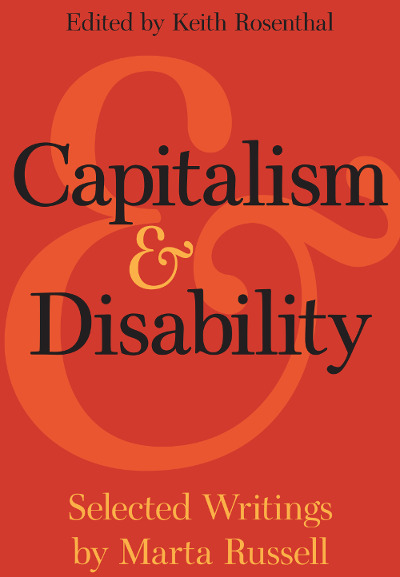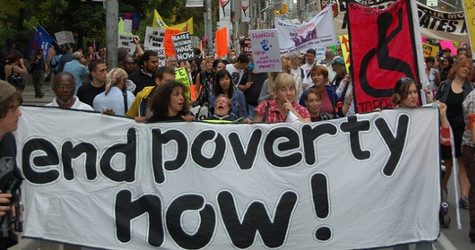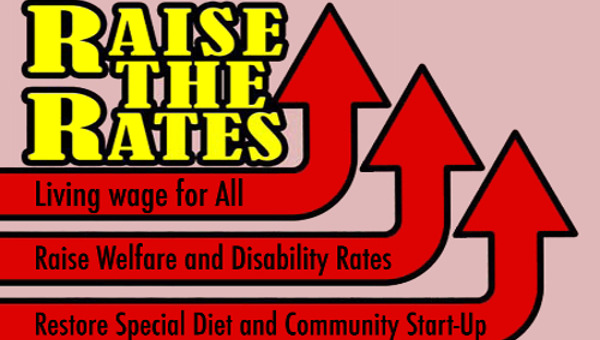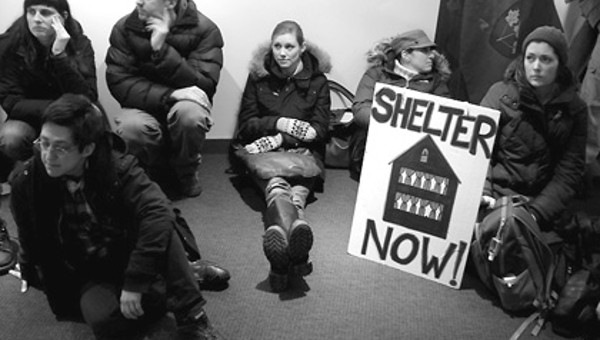Disablement, Oppression, and Political Economy
It is often claimed that disabled persons are invisible, disregarded by mainstream society, and irrelevant to the workings of society. This analysis has attempted to explain that the “unemployables” have been deliberately shut out of the labor force due to a capitalist economy that so far has dictated their exclusion by measure of economic calculations that favor the business class. It further posits that disabled persons are further oppressed in capitalist societies by having been purposely shifted onto social welfare or segregated into institutions for similar reasons – to keep workers who could not be profitably employed out of the mainstream workforce but also to exert social control over the entire labor supply.
 Karl Marx explains that capitalism is a system of “forced labor – no matter how much it may seem to result from free contractual agreement.”1 It is coercion because capitalists own the means of production and laborers do not. Without ownership of factories and other means of production, workers lack their own access to the means of making a livelihood. By this very fact, workers are compelled to sell their labor to capitalists for a wage because the alternative is homelessness or starvation or both. Deborah Stone in The Disabled State convincingly argues that in order to restructure the workforce for the demands of early capitalist production, it was first necessary to eradicate all viable alternatives to wage labor for the mass population.
Karl Marx explains that capitalism is a system of “forced labor – no matter how much it may seem to result from free contractual agreement.”1 It is coercion because capitalists own the means of production and laborers do not. Without ownership of factories and other means of production, workers lack their own access to the means of making a livelihood. By this very fact, workers are compelled to sell their labor to capitalists for a wage because the alternative is homelessness or starvation or both. Deborah Stone in The Disabled State convincingly argues that in order to restructure the workforce for the demands of early capitalist production, it was first necessary to eradicate all viable alternatives to wage labor for the mass population.
Labor is a resource to be manipulated like capital and land. Stone writes, “The disability concept was essential to the development of an exploitable workforce in early capitalism and remains indispensable as an instrument of the state in controlling labor supply.”2
Class Interests Regulating the Labor Supply in Disability Policy
Regulating the composition of the labor force through social policy became key to ensuring an ongoing exploitable labor supply. Disability became an important boundary category through which persons were allocated to either the work-based or needs-based system of distribution. In the United States, disability came to be defined explicitly in relation to the labor market. For instance, in some workers’ compensation statutes, a laborer’s body is rated by impairment according to its functioning parts.3 In Social Security law, disabled means medically unable to engage in work activity.4
Our institutions (particularly medical and social welfare institutions) have historically held disablement to be an individual problem, not the result of economic or social forces.5 They have equated disability with physiological, anatomical, or mental “defects” and hegemonically held these conditions responsible for the disabled person’s lack of full participation in the economic life of our society. This approach presumed a biological inferiority of disabled persons.6 Pathologizing characteristics such as blindness, deafness, and physical and mental impairments that have naturally appeared in the human race throughout history became a means of social control that has relegated disabled persons to isolation and exclusion from society.7 By placing the focus on curing the so-called abnormality and segregating the incurables into the administrative category of disabled, medicine bolstered the capitalist business interest to shove less exploitable workers with impairments out of the workforce.
This exclusion was rationalized by Social Darwinists, who used biology to argue that heredity (race and disability status) prevailed over the class and economic issues raised by Marx and others. Just as the inferior weren’t meant to survive in nature, they weren’t meant to survive in a competitive society. For 19th century tycoons, Social Darwinism proved a marvelous rationale for leaving the surplus population to die in poverty. Capitalism set up production dynamics that devalued less exploitable or nonexploitable bodies, and Social Darwinism theorized their disposability. If it was natural that disabled persons were not to survive, then the capitalist class was off the hook to design a more equitable economic system – one that would accommodate the body that did not conform to the standard worker body driven to labor for owning-class profit.
Social analysts describe the disability needs-based system as a privilege because “as an administrative category, it carries with it permission to be exempt from the work-based system.”8 In conservative terms, disability can be described “an essential part of the moral economy.”9 In the public debate over redistribution of societal resources, public assistance is viewed as legitimate for those deemed unable to work, but the disabled individuals on public benefits under U.S. capitalism do not have any objective right to a decent standard of living, even with privileged status, nor is the definition of disability etched in stone. As Stone pointed out, the definition of disability is flexible; the state (which evaluates disability status) controls the labor supply by expanding or contracting the numbers of persons who qualify as disabled, often for political and economic reasons.10
Neither privilege nor morality theories adequately describe the function of the needs-based system. A political economy analyst would ask what role do public disability benefits play to further the machinations of production and wealth accumulation?
The vast majority of those on Social Security Disability Insurance (SSDI), the deserving workers involuntarily severed from their wages, are not privileged. They are financially oppressed by less than adequate aid. Public disability benefits hover at what is determined an official poverty level. In 2000, the Department of Health and Human Services set the poverty threshold for one at $8,350. Because $759 was the average per month benefit that a disabled worker received from SSDI and $373 was the average federal income for the needs-based Supplemental Security Income (SSI), the annual income of more than 10 million disabled persons on these programs was between $4,000 and $10,000 that year. The extremely low SSI benefit was set up for those with no work history or not enough quarters of work to qualify for SSDI: the least valued disabled members of society.
It would not accurately describe the depth of poverty faced by those on disability benefits, however, without explaining that the current system of measuring poverty dates back to the 1960s. Government has never adjusted the equation to take into account the sharp rise in housing, medical care, and child-care costs of the following decades that have altered the average household’s economic picture. The Urban Institute concluded that in order to be comparable to the original threshold, the poverty level would have to be at least 50% higher than the current official standard. If basic needs were refigured to the modern market, almost a quarter of the American people would be deemed to be living in poverty.11
Most important, public policy that equates disablement with poverty means that becoming disabled (a nonworker) translates into a life of financial hardship, whether one has public insurance or not, and generates a very realistic fear in workers of becoming disabled. At base, the inadequate safety net is a product of the owning class’s fear of losing control of the means of production. The all-encompassing value placed on work is necessary to produce wealth. The American work ethic is a mechanism of social control that ensures capitalists of a reliable work force for making profits. If workers were provided with a federal social safety net that adequately protected them through unemployment, sickness, disability, and old age, then business would have less control over the workforce because labor would gain a stronger position from which to negotiate their conditions of employment, such as fair wages and safe working conditions. American business retains its power over the working class through a fear of destitution that would be weakened if the safety net were to actually become safe. This, in turn, causes oppression for the less valued nonworking disabled members of our society; those who do not provide a body to support profit making (for whatever reason) are relegated to economic hardship or institutionalized to shore up the capitalist system.12 Nursing homes, for instance, have commodified disabled bodies so that the least productive can be made of use to the economic order.
A materialist analysis suggests that capitalism has created a powerful class of persons dependent upon the productive labor of some and the exclusion of others. Business owners and Wall Street investors rely on the preservation of the status quo labor system (not having to absorb the nonstandard costs disabled workers represent in the current mode of production or the reserve army of unemployed).[…] The US work-based/needs-based system is a socially legitimized means by which business and investors can economically discriminate and “morally” shift the cost of disabled workers onto poverty-based government benefit programs rather than be required to hire or retain the unemployables as members of the mainstream workforce.
Consequently, disabled individuals currently not in the workforce collecting SSDI or SSI who could work with an accommodation are not tallied into employers’ cost of doing business. Employers do not pay direct premiums for Social Security disability programs. (The cost of direct government and private payments to support disabled persons of employable age who do not have a job is estimated to be $232-billion annually). Instead, disabled persons have no right to a job. Civil rights laws do not intervene in the labor market to mandate employment of disabled persons (not even to adhere to affirmative action, much less to a quota system like Germany’s); rather, these costs are shifted onto the shoulders of the working class and the low middle class who pay the majority of Social Security taxes while business and our economic system is absolved of responsibility. This analysis is not suggesting that benefits be dissolved; employment discrimination is related to reliance on public aid because those who experience labor market discrimination are also more likely to need public assistance.13 It does suggest that capitalism is a system that forces nondisabled persons into the labor market but also just as forcefully coerces many disabled persons out. Oppression occurs in either case.
Lingering Questions
A Marxian analysis demonstrates that the employment predicament of disabled persons is produced by the economic and social forces of capitalism. The mode of production is key to explaining the organization of society, to preserving existing class relations of production. It is neither arbitrary nor irrational that disabled persons have been excluded from education, transportation, and other social spheres. Rather, it is logical that such a state of affairs would exist as long as disabled persons have little value as workers to the capitalist class.
The civil rights model holds that disabled persons need the protections afforded by the ADA to help shrink the pervasive gaps that still exist between them and nondisabled Americans. This equal opportunity approach, however, assumes that the employment needs of disabled people can be solved under our present economic system.[…] The economy dictates that large numbers of the disabled population will be left jobless or working at subminimum wages regardless of disability civil rights laws. Is this acceptable? Is the disability rights movement’s goal only to see that some, not even all, disabled persons are “free” to be boldly exploited like everyone else?
Liberalism presumes a free, rational, autonomous human can exist under capitalism, but oppression is a permanent factor of any class-based economic system. Marx saw capitalism as a block to workers’ autonomy. Economic change, he deemed, was necessary for the full realization of each person’s human potential. Marx’s final goal, however, was not economic revolution, but human change.
Erich Fromm points out that “the goal of [Marx’s] atheistic radical humanism was the salvation of man, his self-actualization, the overcoming of the craving for having and consumption, his freedom and independence, and his love for others.”14 Marx believed that individual autonomy is interwoven with and dependent upon social relations. Labor power is something that must be created and controlled in a manner appropriate to the maintenance of the capitalist social relation. Exploitation is a common feature of all modes of production that are split into classes. Alienation is a consequence of the mercantilization of human life as a whole by the capitalist relations of production. Wage labor is the transformation of human energy into a commodity like any other piece of matter. So, if the masses were to have freedom and autonomy, Marx believed there must be a transformation of alienated, meaningless labor into productive, free labor, not simply employment or employment at higher wages by a private or state capitalism.
In our society, humane concerns are subsumed by the market’s tyranny, the inversion or camera obscura of what is needed to foster an inclusive, cooperative, and healthy society. Questions that need to be brought to the forefront might include the following: What is the purpose of an economy – to support market-driven profits or to sustain social bonds and encourage human participation? Is it acceptable to reduce the productive activities of persons to commodity wage labor? Is the capacity to produce for profit an acceptable measure of human worth? Is it defensible to hold in contempt bodies that do not produce the way the capitalist class demands, leaving disabled persons to struggle on low wages or meager benefit checks or to be institutionalized? How can the realm of work be reorganized to provide accommodations for all, and how can all members of society be embraced and rewarded whether they work or not?
The disability rights/independent living liberation struggle provides a strong motive for historical change. There is an opportunity to reconceptualize disability and to eliminate disabled peoples’ oppression. We must contest the biological rationale for the exclusion of disabled persons from the realm of work and replace it with a materialistic rationale calling for drastically and justly altering the political economy.
The fundamental questions of class power raised by Marx must be addressed politically if the long-term goal of a society of equals, where “from each according to their [dis]ability, to each according to their need”15 is to materialize. •
This article is excerpted from Capitalism and Disability: Selected Writings by Marta Russell, edited by Keith Rosenthal, Haymarket Books 2019.
Endnotes
- Karl Marx, Capital: A Critical Analysis of Capitalist Production, 3 vols. (1867; reprint, New York: International Publishers, 1967), 819.
- Deborah Stone, The Disabled State (Philadelphia: Temple University Press, 1984).
- E.D. Berkowitz, Disabled Policy: America’s Programs for the Handicapped (Cambridge, UK: Cambridge University Press, 1987).
- Ibid.
- C. Barnes, G. Mercer and T. Shakespeare, Exploring Disability: A Sociological Introduction (Cambridge, UK: Polity Press, 1999); Oliver, Politics.
- H. Hahn, “Public Support for Rehabilitation Programs,” Disability, Handicap and Society 2, no. 1 (1986): 121-38.
- Michael Oliver, The Politics of Disablement (New York: St. Martin’s Press, 1990).
- Stone, Disabled State, 28.
- Ibid., 143.
- Ibid.
- P. Ruggles, Drawing the Line: Alternative Poverty Measures and Their Implications for Public Policy (Washington, DC: Urban Institute Press, 1990).
- Marta Russell, Beyond Ramps: Disability at the End of the Social Contract (Monroe, Maine: Common Courage Press, 1998), 81-3.
- H. Boushey, “The Political Economy of Employment Inequality: Job Access and Pay Differentials,” in Political Economy and Contemporary Capitalism, R. Baiman, H. Boushey and D. Saunders, eds. (New York: M. E. Sharp, 2000).
- Erich Fromm, On Being Human (New York: Continuum Publishing, 1994), 139.
- Karl Marx, Critique of the Gotha Programme (1895; reprint, New York: International Publishers, 1938), 10. [dis], author’s addition.





